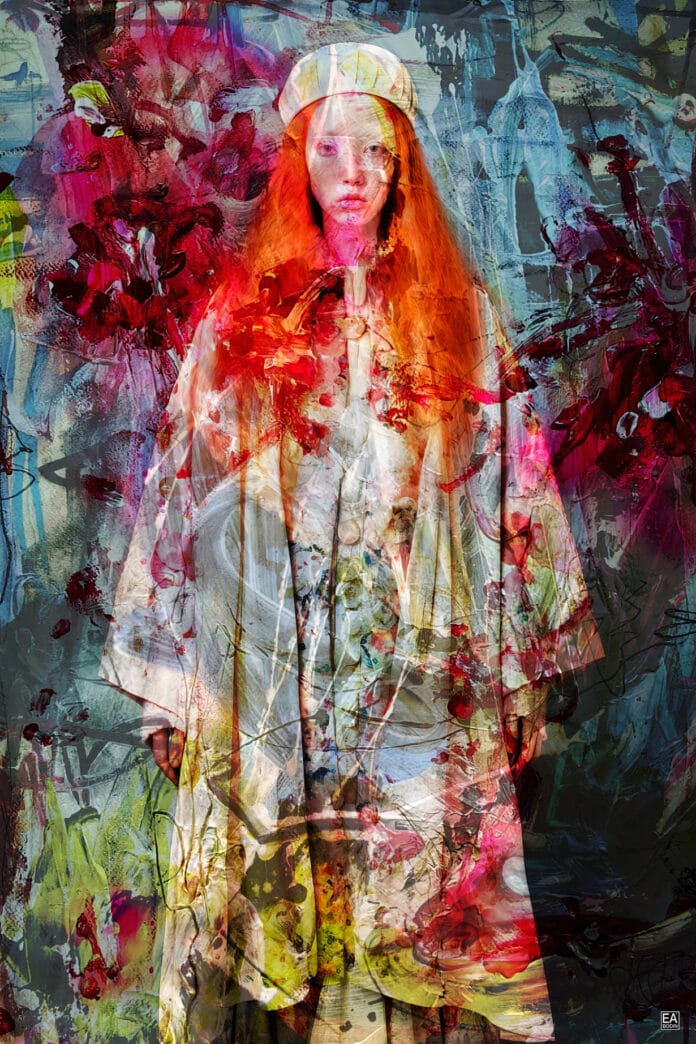In Fused Identity, Danish artist Ea Bodin invites viewers into a contemplative space where the boundaries between technology and soul gently dissolve. At the heart of this striking work is a red-haired muse—neither fully real nor entirely artificial—emerging from layers of brushstrokes that are both digital and tangible. The image resonates with quiet tension: artificial intelligence provides the form, while the artist’s hand breathes life into the silhouette. The result is not merely a portrait, but a poetic meditation on the shifting nature of self in a hybrid age.
Through this one-of-a-kind mixed-media work, Bodin captures more than a face—she captures a process of becoming. Identity, as the title suggests, is not static. It fuses, unfurls, and reforms within each viewer’s gaze. The brushstrokes evoke warmth and humanity, while the machine-generated form introduces precision and unfamiliarity. Fused Identity is not only an artwork; it is an invitation to consider how consciousness can exist within—and beyond—the codes we write.
The Artist: Ea Bodin’s Journey of Fusion
Ea Bodin is a Danish artist currently living and working in Germany. While she first gained recognition for her abstract paintings, her recent Abstract-AI series has carved a new path in contemporary art—one where digital tools are not replacements for creativity, but companions to it. In this body of work, she merges AI-generated portraits with hand-painted textures to craft emotionally resonant images that feel both futuristic and deeply human.
As an artist, designer, and trained hypnotherapist, Bodin brings a multidimensional awareness to her work. Her understanding of the subconscious and emotional resonance translates into a visual language that is meditative, gentle, and often transformative. Each piece seems to hold a subtle vibration—an energetic frequency that touches something within the viewer. In her hands, technology does not become a barrier to intimacy but a gateway to it.
The Technique: Where Algorithm Meets Intuition
Ea Bodin’s process is as layered as her finished pieces. She begins with AI-generated portraits—constructed from code, datasets, and algorithmic intelligence. These digital renderings act as the framework, not the finish line. From there, she moves into tactile space: printing, painting, and layering over the image with organic textures, colors, and brushstrokes that transform the coldness of digital precision into something warm and alive.
This fusion between algorithm and intuition is not seamless, and that’s the point. The tension between control and spontaneity, machine and soul, becomes the heartbeat of each composition. In Fused Identity, we see how this duality plays out in visual form: the smooth structure of the AI contrasts with the unruly emotion of hand-painted texture. The effect is hauntingly beautiful, like hearing a familiar song through an unfamiliar voice.
A Meditation in Motion
What distinguishes Ea Bodin’s work is its emotional depth. While many contemporary digital artworks lean toward spectacle or conceptual detachment, Bodin’s images invite a quieter experience. Her pieces function like mirrors—reflecting back inner states, questions, and possibilities. They feel less like statements and more like moments of pause.
Her work can be seen as a kind of “meditation in motion.” The compositions unfold slowly, drawing the viewer into an experience that is both visual and visceral. In Fused Identity, for example, the red-haired muse seems to gaze from within, not outward. Her presence is neither demanding nor decorative; it is reflective, inviting a similar internal awareness in the observer.
Art as Inner Technology
At the core of Ea Bodin’s practice is a belief that technology, when approached consciously, can deepen human connection rather than diminish it. This philosophy is evident in Fused Identity and throughout the Abstract-AI series. By embedding hand-painted emotion into digital frameworks, Bodin creates artworks that are not only visually compelling but spiritually resonant.
In an era where AI is often viewed with skepticism or fear, Bodin reframes the conversation. Her work asks: What if machines could become co-creators, not competitors? What if digital tools could be used not to replicate human creativity, but to enhance its reach? Through her gentle and intentional approach, Bodin positions technology not as the future of art, but as its present—when guided by empathy and presence.
Fused Identity as a Symbol
As a singular piece, Fused Identity functions as a symbol of our time. It reflects the cultural moment in which we live: one defined by hybridity, transformation, and the dissolution of binaries. We are no longer fully analog, nor entirely digital. We are layered beings navigating a layered world. In this context, Bodin’s work does not seek to provide answers—it offers a visual language for asking deeper questions.
Who are we when our identities are shaped by both memory and machine? What part of us remains unchanged, and what part is always evolving? How can we remain rooted while embracing the fluidity of modern life?
In Fused Identity, these questions are not spelled out—they’re felt. And perhaps that’s where art speaks loudest.
A Vision of Soulful Technology
Ea Bodin’s Fused Identity is more than a fusion of materials; it is a fusion of worlds. It is where art history meets the digital present, where soul meets structure, and where an image becomes a moment of inner recognition. Through her innovative use of AI and paint, Bodin crafts a new kind of portraiture—one that is not fixed in likeness, but fluid in meaning.
In this fusion, she offers a quiet revolution. One in which art is not consumed but contemplated. One in which technology serves intimacy, not isolation. And one in which identity, like the muse she paints, is always becoming.


